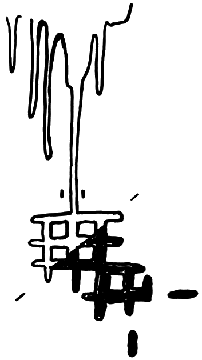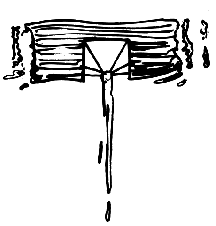|
Stuart Horodner | ||
The parts lay here, waiting to be made whole, and when they are combined, one portion of my research will be complete. I'm collecting images and texts, rendering with them, the outlines of a body. Whose body? As each separate element is laid out, I wonder if a tale of fragments can be told seamlessly. Should it not somehow retain the difficulties of joining, the attempts to sum up, and the falling back into pieces? This Frankenstein project has been going on for over a year, or has it? Perhaps it began at my beginning, as there are moments when I think I have never not been working on it. Encounters with things Frankensteinian started to happen. I found them or they found me. Either way, I was alert to them, and they seemed to be everywhere. A New Yorker cartoon showed the monster at a bar, offering to buy his potential bride a drink.1 A National Geographic article on minor league baseball, included a photo of a pitcher, who had been hit in the face by a smoking line drive that left an imprint of the ball's stitches. He said, "my teammates called me Frankenstein."2 The lyrics of Sam Cooke's, "Another Saturday Night," told a lonely man's saga:
Oh another Saturday night and I ain't got nobody I've got some money 'cause I just got paid Now how I wish I had someone to talk to I'm in an awful way. Another fella told me He had a sister who looked just fine Instead of bein' my deliv'rance She had a strange resem'blance to a cat named Frankenstein.3
The list goes on. But I'm getting ahead of myself. It was Branagh's movie that forced me to search out the novel. The $2.95 paperback copy that I bought at a used bookstore had a hyper realistic painting of Karloff as the monster on the cover. I began reading Mary Shelley's book; making notes in red pencil, underlining passages and filling the margins with question marks and shorthand responses. I felt at home. I recalled conversations with my father, questions of "who are you, and who do you want to be?" (Key questions for any journey of self-construction) I thought of his company, C&R Arts Services (C for copy, R for restoration); a photo lab that "repaired" old family photographs, cropping out unwanted figures, fixing (with airbrush, pencils, and oil paints) the variety of cracks, tears, spots, and stains that time and place had caused. My father processed people and their memories for a living. I remembered the summer when I worked in the darkroom, handling hundreds of prints, moving them from developer to stop bath, fix, toner, water; the strange figures and families looking up at me. And later, feeding them face down on the cotton belt that led into the dryer. I was reading about Victor Frankenstein's "workshop of filthy creation" in a "solitary chamber or rather cell, at the top of the house," when it dawned on me; he's an artist. His lab, his isolation, his impractical desire "to animate the lifeless clay"; how different was this from the studios I visited in Manhattan or Brooklyn, filled with paintings, photos or sculptures, where the artists stood in context, in the space of making and judging. At each visit, I was aware of a moment when I was there but removed, seeing myself seeing the work, seeing myself talking to the artists. I thought of them too, at work, aware of themselves, inside and outside at once. I thought of the tricks we use, to avoid the logic of habit; chance operations, play, various cut-up techniques, anything to allow for the losing oneself that is necessary. Anything that will stave off the voices of teachers, friends, role models, other works. A partial list of ones who "haunt" me would include: Richard Brautigan, Alice Neel, Charles Bukowski, R.B. Kitaj, Reuben Kadish, and Philip Guston. It was Guston who said,
I believe it was John Cage, who once told me, "When you start working everybody is in your studio-the past, your friends, enemies, the art world, and above all, your own ideas-all are there. But as you continue painting, they start leaving, one by one, and you are left completely alone. Then, if you are lucky, even you leave."4
I thought of the studio; part prison, showroom, office, womb, brain. A place that one constructs with wishes and practicality. (I would like one with wooden floors, high ceilings, big windows, and a freight elevator, but only have so much to spend.) It is a place where one is allowed not to know; where one makes things and destroys them, where as Picasso said, "Nothing is lost, the red taken from one place turns up somewhere else." Artists have told us of moments in the studio when chaos yields order, when "the air of the arbitrary vanishes," when the work itself begins to speak. When the figure in the marble, a final form merely waiting to be released, was excavated by hand and chisel. When a painting knew how it needed to be finished and told the painter. William Gibson, writing about the World Wide Web, seems to have a handle on it:
The Web is new, and our response to it has not yet hardened. That is a large part of its appeal. It is something half-formed, growing. Larval. It is not what it was six months ago; in another six months it will be something else again. It was not planned; it simply happened, is happening. 5
These moments, guided by intellect, intuition, and physics (how the oil paint dries, the glue holds, the basketballs float, the lard collapses, etc.) produce the "work." Victor Frankenstein describes such a moment:
With an anxiety that almost amounted to agony, I collected the instruments of life around me, that I might infuse a spark of being into the lifeless thing that lay at my feet. It was already one in the morning; the rain pattered dismally against the panes, and my candle was nearly burned out, when, by the glimmer of the half-extinguished light, I saw the dull yellow eye of the creature open; it breathed hard, and a convulsive motion agitated its limbs.6
What happens next is critical. As the work "opens it's eye" so to speak, it begins a life in the land of its creator. The two are eternally linked. They will speak for each other. Their status as maker and made will collapse, as when we think "Frankenstein" and conjure the monster, not Victor. If you close your eyes and think deKooning, what appears? The artist and artwork keep company in the world of politicians, super models and unabombers, 12 step programs, Mozart and museums, sunsets, blood and dust. They are both constructions. In a rethinking of Robert Rauschenbergs's statement that, "Painting relates to both art and life. Neither can be made. (I try to act in that gap between the two.)"; they remove the gap, offering that art and life are both made. They are complicated blends of experience, fear, spirit, and matter.
How can I describe my emotions at this catastrophe, or how delineate the wretch whom with such infinite pains and care I had endeavored to form? His limbs were in proportion, and I had selected his features as beautiful. Beautiful! Great God! His yellow skin scarcely covered the work of muscles and arteries beneath; his hair was of a lustrous black, and flowing; his teeth of a pearly whiteness; but these luxuriances only formed a more horrid contrast with his watery eyes, that seemed almost of the same colour as the dun white sockets in which they were set, his shriveled complexion and straight black lips. 7
This is the description of the creature's first moment; and then immediately, with the "beauty of the dream vanished" and "breathless horror and disgust" filling his heart, Victor runs from the room. This is his tragic flaw. Stephen Jay Gould points out, in his essay, The "Monster's Human Nature," that "Victor failed because he followed a predisposition of human nature-visceral disgust at the monster's appearance-and did not undertake the duty of any creator or parent: to teach his own charge and to educate others in acceptability."8 He did not have the benefit of Alberto Giacometti, discussing his engagement with the human image:
I know that it is utterly impossible for me to model, paint or draw a head, for instance, as I see it and, still, this is the only thing I am attempting to do. All that I will be able to make will be only a pale image of what I see and my success will always be less than my failure or, perhaps, the success will be equal to my failure. I do not know whether I work in order to make something or in order to know why I cannot make what I would like to make.9
Or the awareness of Leon Golub, telling me about a self-dialogue:
Working on something, I ask, "Am I getting too soft? Is the thing easing up too much? Am I just smoothing out the edges of what I've done?" So I say "Watch it." Another part of me says, "For Christ's sake man, do you really have to be so fucking ugly? Do you really have to be? Can't you just take it from another angle?" Then I think, "Well, maybe I can't, you see. Being who I am, you know, I can't. Or if I can, I don't want to." 10
This is the sentient body I am outlining. Within its borders are Jeanne Silverthorne and Fischli / Weiss fabricating the details of a studio fiction; Curtis Mitchell and Hannah Wilke suspending beauty; father and son, Francois and Didier Morelli negotiating an exquisite corpse; Tim Hawkinson building a respiratory system with plastic bottles and bits of metal; Jack Whitten and Fabian Marcaccio altering the genetics of painting; Lucy Grealy's lovesick protagonist; Laura Stein's and Sue Johnson's graftings of flora and fauna; Nancy Burson, Lisa Yuskavage, Bradley Rubinstein, and Ida Applebroog, each fashioning a "one of a kind" figure; and Larry Miller's mirror, catching him in the act. These , and the other artists included in this issue of New Observations, are roughly considered under the headings I noted in my worn copy of Shelley's novel: doctor=artist, lab=studio, monster=artwork. They have each conducted their own experiments, forged their own dreams and beasts. I respectfully borrow their efforts here, not as illustrations of a classic text, but as a possible guide to the me that is other, the territory called Frankenstein. It is a condition of, "I am he as you are he as you are me and we are all together."11
Notes
1. The New Yorker, April 22, 1996, p.47.
2. David Lamb, "A Season in the Minors", National Geographic, April, 1991,
pp. 60-61.
3. Sam Cooke, "Another Saturday Night," 1963, Kags Music Corp.
4. Philip Guston, It Is, no. 5, Spring 1960, pp. 36-38.
5. William Gibson, "The Net Is A Waste Of Time (And that's exactly what's right about
it.)," The New York Times Magazine, Sunday, July 14, 1996, p.31.
6. Mary Shelley, Frankenstein or The Modern Prometheus, Bantam Books,
New York, 1967, p.42.
7. Ibid.
8. Stephen Jay Gould, "The Monster's Human Nature," in Dinosaurs In A
Haystack, Harmony Books, New York, 1995, p. 61.
9. Alberto Giacommetti, Paris, May 17, 1959, Statement included in New Images Of
Man, Museum of Modern Art, New York, 1959, p. 68.
10. Leon Golub, New York, June 13, 1996.
11. John Lennon - Paul McCartney, "I am the Walrus," 1967, Comet Music Corp.
|
copyright ©1996-7 NEW OBSERVATIONS Ltd., and the authors. All Rights Reserved

